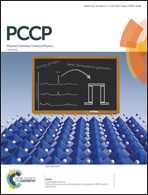Role of Ni in hetero-architectured NiO/Ni composites for enhanced catalytic performance
Abstract
A facile, one-step combustion synthesis in solution is reported for preparing hetero-architectured NiO/Ni nanocomposites using different organic fuels. The prepared nanocomposites were physicochemically characterized for crystal structure, functional groups, and morphology. It was found that the content of Ni in the nanocomposite varied due to different combustion fuels. A photocatalytic (PC) investigation of these nanocomposites was performed using rhodamine 6G (RG) under UV light. A citric acid combusted NiO/Ni (N-CA) composite containing 20% Ni phase showed the highest photoactivity in comparison to pure NiO due to its large porous channels and high surface area (∼28 ± 2 m2 g−1). The N-CA catalyst was further evaluated for the degradation of cationic, anionic dyes and chloro/nitro-phenols under both UV and visible light. Photoelectrocatalysis (PEC) of RG with N-CA resulted in complete degradation of the dye. The mechanism governing the catalytic processes was determined from the trapping experiments. The potential reasons for the enhanced photoactivity of the NiO/Ni nanocomposite were that Ni acted as an electron sink, and the applied bias of +1.0 V separated the electron–hole, reducing its rate of recombination.



 Please wait while we load your content...
Please wait while we load your content...